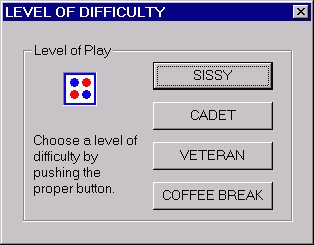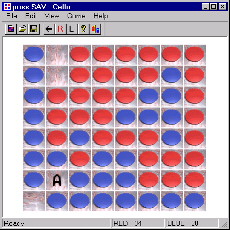 CELLO TUTORIAL
CELLO TUTORIAL
Welcome to the CELLO online tutorial.
This tutorial will teach you how to run the CELLO computer program. Several
lessons are available. Click on a title to start the tutorial.
LESSON 1:
Basic Game Play and Rules.
LESSON 2:
More Advanced Features.
LESSON 3:
Video Demonstration.
LESSON 1:
Basic Game Play and Rules.
In this lesson you will learn the basic game rules,
learn how to play the game, and become familiar with some basic features.
Start the cello
application by running Cello.exe. (For installation related issues, see
the readme.txt file). Cello is played on an eight by eight board, with
blue and red markers. When Cello starts, it should appear as shown below:

The game window is divided into four major areas:
the Main Menu, the Tool Bar, the Game Board, and the Status Bar. Most game
play is conducted in the Game Board area. Using the mouse, click in the
square labeled A. Notice that a (friendly) red marker is placed in the
chosen square. All enemy (blue) markers "surrounded" by red markers are
captured, and also turn red. Notice also that the computer, almost instantly,
makes a counter-attack.
 Cello board after red (user) move.
Cello board after red (user) move.
|
 Cello board after computer counter-attack.
Cello board after computer counter-attack.
|
For a move to be legal, you must capture at least
one enemy marker by surrounding it. Surrounding an enemy marker consists
of moving next to it. You must also have a friendly marker past the enemy
markers on the same row. No empty squares can intervene. All enemy markers
meeting this criteria are captured on the same move. Diagonal rows count
as well... blah, blah, blah... - Try a few moves, and you will see. Cello
enforces the rules!
Try holding the mouse over the 'L' icon in the tool bar.
Notice the context sensitive help information displayed in the left pane
of the status bar. Try moving the mouse over some of the other icons on
the tool bar (A complete description of each menu command can be found
in the User Manual).
Now change the level of play. Push the 'L' icon
in the tool bar. This will cause the dialog box, shown below, to pop up
on the screen.
 Level of Difficulty Dialog Box
Push the "Cadet" button. The dialog box will disappear.
You are now playing Cello at an easier level, since the default level is
"Veteran".
Level of Difficulty Dialog Box
Push the "Cadet" button. The dialog box will disappear.
You are now playing Cello at an easier level, since the default level is
"Veteran".
LESSON 2:
More Advanced Features.
Now that you are somewhat familiar with playing
Cello, let's explore some more advanced features. First start Cello, and
make a few moves. Suppose you accidentally selected the wrong location
for a move. Wait until the computer is done moving, then select Game->Undo
for another chance. Try it now. Notice that Cello takes back your last
move, and the computer's response.
Start a new game by selecting File->New
from the menu. You will be promted to save the current game. Push "Yes".
Choose a directory, and type in a file name using a .sav extension. Press
"Save" to save the game. This time let the computer move first by selecting
Game->Pass from the menu. The computer will
move, and it is your turn. You will also need to pass if (and only if)
you have no legal moves sometime during a game. The program will prompt
you to pass.
To see how this works, load "pass.sav" from the
Cello/Help subdirectory using File->Open.
The board will look like this:
 File pass.sav
Move at the location marked 'A'. After the computer
moves, you will be prompted to pass. Click 'OK'. Then select Game->Pass.
The computer will move, and it will be your turn again.
File pass.sav
Move at the location marked 'A'. After the computer
moves, you will be prompted to pass. Click 'OK'. Then select Game->Pass.
The computer will move, and it will be your turn again.
LESSON
3: Video Demonstration.
Enough talk.
This video, Cello.avi (.avi - Microsoft video
for windows) demonstrates several features of Cello.
HELP HOME
USER MANUAL TUTORIAL
Copyright (c) 1997, James P.
Ivers. All rights reserved.